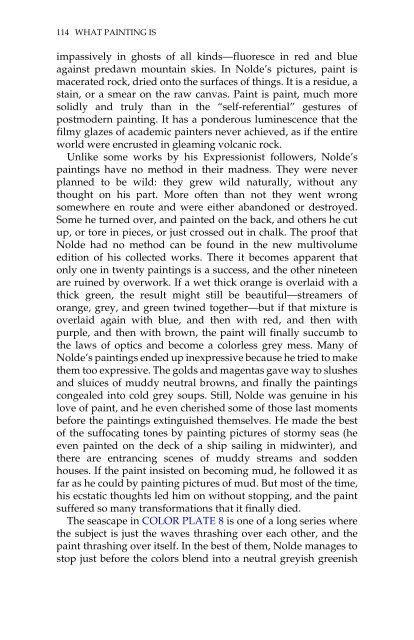What Painting Is: How to Think about Oil Painting ... - Victoria Vesna
What Painting Is: How to Think about Oil Painting ... - Victoria Vesna
What Painting Is: How to Think about Oil Painting ... - Victoria Vesna
You also want an ePaper? Increase the reach of your titles
YUMPU automatically turns print PDFs into web optimized ePapers that Google loves.
114 WHAT PAINTING IS<br />
impassively in ghosts of all kinds—fluoresce in red and blue<br />
against predawn mountain skies. In Nolde’s pictures, paint is<br />
macerated rock, dried on<strong>to</strong> the surfaces of things. It is a residue, a<br />
stain, or a smear on the raw canvas. Paint is paint, much more<br />
solidly and truly than in the “self-referential” gestures of<br />
postmodern painting. It has a ponderous luminescence that the<br />
filmy glazes of academic painters never achieved, as if the entire<br />
world were encrusted in gleaming volcanic rock.<br />
Unlike some works by his Expressionist followers, Nolde’s<br />
paintings have no method in their madness. They were never<br />
planned <strong>to</strong> be wild: they grew wild naturally, without any<br />
thought on his part. More often than not they went wrong<br />
somewhere en route and were either abandoned or destroyed.<br />
Some he turned over, and painted on the back, and others he cut<br />
up, or <strong>to</strong>re in pieces, or just crossed out in chalk. The proof that<br />
Nolde had no method can be found in the new multivolume<br />
edition of his collected works. There it becomes apparent that<br />
only one in twenty paintings is a success, and the other nineteen<br />
are ruined by overwork. If a wet thick orange is overlaid with a<br />
thick green, the result might still be beautiful—streamers of<br />
orange, grey, and green twined <strong>to</strong>gether—but if that mixture is<br />
overlaid again with blue, and then with red, and then with<br />
purple, and then with brown, the paint will finally succumb <strong>to</strong><br />
the laws of optics and become a colorless grey mess. Many of<br />
Nolde’s paintings ended up inexpressive because he tried <strong>to</strong> make<br />
them <strong>to</strong>o expressive. The golds and magentas gave way <strong>to</strong> slushes<br />
and sluices of muddy neutral browns, and finally the paintings<br />
congealed in<strong>to</strong> cold grey soups. Still, Nolde was genuine in his<br />
love of paint, and he even cherished some of those last moments<br />
before the paintings extinguished themselves. He made the best<br />
of the suffocating <strong>to</strong>nes by painting pictures of s<strong>to</strong>rmy seas (he<br />
even painted on the deck of a ship sailing in midwinter), and<br />
there are entrancing scenes of muddy streams and sodden<br />
houses. If the paint insisted on becoming mud, he followed it as<br />
far as he could by painting pictures of mud. But most of the time,<br />
his ecstatic thoughts led him on without s<strong>to</strong>pping, and the paint<br />
suffered so many transformations that it finally died.<br />
The seascape in COLOR PLATE 8 is one of a long series where<br />
the subject is just the waves thrashing over each other, and the<br />
paint thrashing over itself. In the best of them, Nolde manages <strong>to</strong><br />
s<strong>to</strong>p just before the colors blend in<strong>to</strong> a neutral greyish greenish


